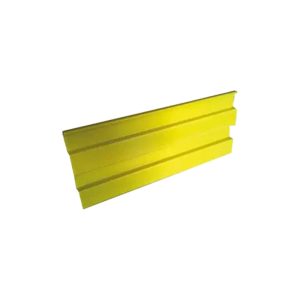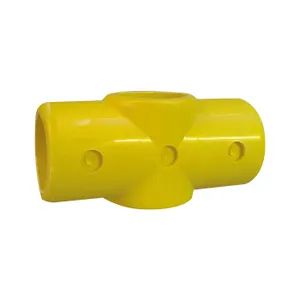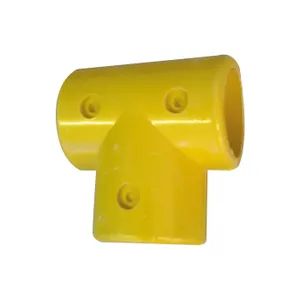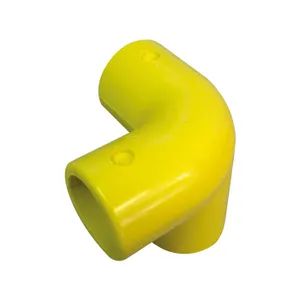당사의 GRP 핸드레일 시스템은 종종 GRP 핸드레일 또는 가드레일에 사용되어 90° 코너에서 중간 레일을 계속하거나 수직 포스트를 상단 레일에 연결하거나 미드레일을 엔드 포스트에 연결합니다.
제품 성능 소개
|
|
GRP 외부 스위블은 다용도 인라인 스위블 피팅으로 슬롭, 계단 및 계단참에서 각도가 다른 곳에 자주 사용됩니다. |
|
GRP 116 Mid Corner는 90° 코너 조인트로, 90° 코너에서 중간 레일을 이어주기 위해 종종 GRP 핸드레일 또는 가드레일에 사용되지만 직사각형 또는 정사각형 구조를 구축하는 데에도 사용할 수 있습니다. 업라이트는 GRP 피팅을 통해 수직으로 통과합니다. 종종 GRP-128 Top Corner와 함께 사용됩니다. |
|
|
GRP 101 짧은 티는 90° 티 연결로, 일반적으로 수직 포스트를 상단 레일에 연결하거나 미드레일을 엔드 포스트에 연결하기 위해 GRP 핸드레일에 사용됩니다. 튜브는 피팅 상단 내에서 결합될 수 없습니다. 필요한 경우 대안으로 GRP-104 Long Tee를 사용할 수 있습니다. |
|
GRP 피팅 119 미드레일 크로스는 90° 조인트로, 중간 레일을 GRP 핸드레일 또는 가드레일의 중간 직립 기둥에 연결하는 데 자주 사용됩니다. 업라이트는 GRP 피팅을 통해 수직으로 통과합니다. |
|
|
GRP 104 Long Tee는 90° 티 연결로, 일반적으로 수직 기둥을 GRP 핸드레일의 상단 레일에 연결하는 데 사용됩니다. GRP -104는 피팅 상단 내에서 두 개의 튜브 길이를 연결해야 하는 경우에 사용할 수 있습니다. |
|
GRP 125 피팅은 90° 엘보로, 주행 종료 시 상단 레일을 직립 기둥에 연결하기 위해 GRP 핸드레일 또는 가드레일에 자주 사용됩니다. |
|
|
GRP 129는 30° 티 피팅으로 계단 GRP 핸드레일 또는 가드레일에 자주 사용됩니다. |
|
128 Top Corner 피팅은 3방향 피팅입니다. 90° 엘보, 일반적으로 직립 기둥을 90º 코너에서 GRP 핸드레일의 상단 레일에 연결하는 데 사용됩니다. 종종 GRP-116 Mid Corner와 함께 사용됩니다. |
|
|
GRP 130은 30° 크로스로, 종종 계단 GRP 핸드레일의 중간 포스트에 중간 레일을 연결하는 데 사용됩니다. |
|
GRP 116 Mid Corner는 90° 코너 조인트로, 90° 코너에서 중간 레일을 이어주기 위해 종종 GRP 핸드레일 또는 가드레일에 사용되지만 직사각형 또는 정사각형 구조를 구축하는 데에도 사용할 수 있습니다. 업라이트는 GRP 피팅을 통해 수직으로 통과합니다. 종종 GRP-128 Top Corner와 함께 사용됩니다. |
|
|
GRP 132 베이스 플레이트는 4개의 고정 구멍이 있는 베이스 플랜지로 핸드레일이나 가드레일의 직립 기둥을 고정하는 데 사용됩니다. |
|
GRP 173 싱글 스위블은 다용도 스위블 피팅으로 경사, 계단 및 계단참에서 각도가 다른 곳에 사용됩니다. |
|
|
145 벽면 소켓은 GRP 핸드레일 또는 가드레일을 벽, 경사로 및 계단에 측면 고정하기 위해 설계된 GRP 피팅입니다. |  |
당사의 GRP 킥 플레이트는 폭이 100mm이고 벽이 5mm입니다. 6m 길이로 재고가 있지만 필요한 경우 길이로 절단할 수 있습니다. |
중국산 유리 강화 플라스틱(GRP), TFcomposite의 GRP 핸드레일 시스템은 강철보다 중요한 이점을 제공하여 수처리 작업에서 철도 산업에 이르기까지 모든 곳에서 GRP 핸드레일을 볼 수 있는 이유를 설명합니다.
유리섬유강화플라스틱(FRP) 난간 시스템은 산업, 상업 및 건축 분야에서 안전과 접근성을 확보하는 데 탁월한 내구성을 자랑하는 첨단 솔루션입니다. 강도, 내식성, 그리고 낮은 유지보수 비용이 장점으로 꼽히는 FRP 난간은 강철이나 목재와 같은 기존 소재가 혹독한 환경에 노출되어 손상될 수 있는 환경에 이상적입니다. 본 문서에서는 FRP 난간 시스템의 구성 요소, 장점, 적용 분야, 설치 과정 및 유지보수에 대해 자세히 살펴봅니다.
1. FRP 난간 시스템이란 무엇입니까?
FRP 난간 시스템은 유리 섬유 강화 플라스틱으로 제작된 모듈식 또는 사전 설계된 안전 장벽 시스템입니다. FRP는 강한 섬유와 고분자 매트릭스를 결합한 복합 소재로, 가볍고 견고하며 부식, 화학 물질 및 자외선에 대한 저항성이 뛰어납니다.
주요 구성 요소
FRP 난간 시스템은 일반적으로 다음과 같은 구성 요소로 이루어져 있습니다.
- 울타리수평 구성 요소는 지속적인 지지력을 제공합니다.
- 게시물레일을 지지하기 위해 지면이나 구조물에 고정된 수직 요소.
- 무릎 보호대: 추가적인 지지력과 안전을 위한 보조 수평 레일.
- 발판공구나 파편이 떨어지는 것을 방지하는 기본 구성 요소.
- 피팅시스템을 하나로 묶어주는 커넥터, 브래킷 및 고정 장치.
- 받침대 및 마운트시스템을 바닥, 벽 또는 기타 표면에 고정하는 데 사용됩니다.
2. 재료 및 제조
FRP 난간 시스템은 크게 두 가지 제조 방법을 사용하여 생산됩니다.
- 풀트루전:
- 연속 섬유는 수지 욕조와 가열된 다이를 통과하여 뽑힙니다.
- 균일한 강도와 매끄러운 마감을 보장합니다.
- 조형:
- 유리섬유 매트 또는 직조 로빙을 겹겹이 쌓고 틀에 넣어 수지를 주입합니다.
- 복잡하거나 맞춤형 모양에 자주 사용됩니다.
FRP 난간에 사용되는 일반적인 재료
- 섬유일반적으로 높은 인장 강도를 위해 유리 섬유를 사용합니다.
- 수지 종류:
- 폴리에스테르비용 효율적이며 화학 물질에 대한 내성이 중간 정도입니다.
- 비닐 에스테르화학 물질 및 열에 대한 저항성이 더 높습니다.
- 에폭시: 뛰어난 기계적 강도와 접착력.
자외선 차단제, 난연제, 안료와 같은 첨가제를 첨가하여 성능과 미관을 향상시킬 수 있습니다.
3. FRP 난간 시스템의 주요 이점
FRP 난간 시스템은 기존 재료에 비해 여러 가지 장점을 제공합니다.
3.1. 내식성
- 화학 물질, 해수 또는 습기에 노출되는 환경에 이상적입니다.
- 폐수 처리 시설, 해양 분야 및 화학 처리 시설에서 사용됩니다.
3.2. 가볍고 설치가 간편함
- 강철이나 알루미늄보다 무게가 훨씬 가벼워 운송비와 인건비가 절감됩니다.
- 모듈식 설계는 특수 도구 없이도 쉽게 조립할 수 있도록 해주는 경우가 많습니다.
3.3. 높은 강도 대 무게 비율
- 기존 소재와 동등하거나 그 이상의 강도를 제공하면서도 부피는 더 작습니다.
3.4. 내구성 및 수명
- 균열, 변형 및 시간이 지나도 열화되지 않습니다.
- 극한 환경에서도 긴 수명을 자랑합니다.
3.5. 유지보수가 적음
- 도색이나 잦은 점검이 필요하지 않습니다.
- 녹 및 미생물 번식에 강합니다.
3.6. 전기 및 열 절연
- 비전도성 소재이므로 전기 환경에서도 안전합니다.
- 낮은 열전도율은 고온 환경에서 화상 위험을 줄여줍니다.
3.7. 맞춤 설정 기능
- 특정 요구 사항에 맞춰 다양한 색상, 크기 및 구성으로 제공됩니다.
- 심미적인 옵션은 건축 디자인과의 조화를 향상시킵니다.
4. FRP 난간 시스템의 적용 분야
FRP 난간은 뛰어난 적응성과 견고성 덕분에 다양한 산업 분야에서 사용됩니다. 주요 적용 분야의 예는 다음과 같습니다.
4.1. 산업 시설
- 화학공장화학 물질 튀김 및 증기에 견딜 수 있어야 합니다.
- 석유 및 가스부식 방지 특성으로 해양 및 육상 시설의 수명을 연장할 수 있습니다.
- 발전소비전도성 특성은 변전소의 안전성을 보장합니다.
4.2. 물 및 폐수 처리 시설
- 염소, 산, 습기에 강합니다.
- 보행로, 플랫폼 및 탱크 접근로에 이상적입니다.
4.3. 해양 및 연안 환경
- 해수 부식의 영향을 받지 않습니다.
- 부두, 교량 및 해상 플랫폼에서 사용됩니다.
4.4. 공공 기반 시설
- 안전과 미관이 필수적인 교량, 공원 및 보행자 통로.
4.5. 상업용 및 주거용
- 발코니, 계단 및 경사로에 현대적이고 유지 관리가 용이한 난간이 필요합니다.
5. 설계 표준 및 준수
FRP 난간 시스템은 다음과 같은 엄격한 안전 및 엔지니어링 표준을 충족하도록 설계되는 경우가 많습니다.
-
OSHA(미국 산업안전보건청):
- 작업장 안전 지침에 따른 난간 설치 준수를 보장합니다.
- 특정 높이, 강도 및 처짐 특성이 요구됩니다.
-
ASTM(미국재료시험학회):
- 강도, 내구성 및 재료 성능에 대한 시험 기준을 제공합니다.
-
ISO(국제표준화기구):
- 전 세계의 품질 및 환경 안전 기준을 다룹니다.
-
ADA(미국 장애인법):
- 손잡이의 표면이 매끄럽고 높이가 적절해야 하는 등 접근성 관련 기능을 의무화합니다.
6. FRP 난간 시스템 설치
FRP 난간 시스템 설치에는 다음과 같은 단계가 포함됩니다.
6.1. 준비
- 현장 조건을 평가하고 표면이 깨끗하고 평평한지 확인하십시오.
- 사전에 승인된 배치도 또는 엔지니어링 설계도를 기준으로 설치 지점을 표시하십시오.
6.2. 조립
- 표시된 지점에 베이스 마운트 또는 브래킷을 설치하십시오.
- 볼트나 접착제를 사용하여 기둥을 받침대에 고정하십시오.
- 브래킷과 고정 장치를 사용하여 수평 난간과 무릎 난간을 기둥에 고정하십시오.
- 필요한 경우 발판을 부착하십시오.
6.3. 마무리
- 모든 연결부를 단단히 조이고 정렬 상태를 점검하십시오.
- 추가적인 보호가 필요한 경우 밀봉제 또는 코팅제를 도포하십시오.
6.4. 안전성 테스트
- 안전 기준 준수를 보장하기 위해 부하 시험을 수행하십시오.
- 느슨한 연결부나 어긋난 부분이 있는지 점검하십시오.
7. FRP 난간 시스템의 유지보수
FRP 시스템은 최소한의 유지 관리만 필요하지만, 주기적인 점검을 통해 최상의 성능을 보장할 수 있습니다.
7.1. 청소
- 먼지, 이물질 또는 기름때를 제거하려면 순한 비누와 물을 사용하십시오.
- 표면 긁힘을 방지하기 위해 마모성 물질을 사용하지 마십시오.
7.2. 검사
- 부품이나 볼트가 헐거워졌는지, 또는 자재에 균열이 있는지 확인하십시오.
- 이음새와 연결 부위를 정기적으로 점검하십시오.
7.3. 수리
- 손상된 부품은 전체 시스템을 분해하지 않고도 개별적으로 교체할 수 있는 경우가 많습니다.
- 호환되는 접착제 또는 제조업체에서 제공하는 교체 부품을 사용하십시오.
8. 사용자 지정 옵션
FRP 난간 시스템은 맞춤 제작이 매우 용이하여 특정 요구 사항에 맞게 조정할 수 있습니다.
- 그림 물감노란색, 녹색, 회색 또는 브랜드나 안전 코드에 맞는 맞춤 색상.
- 크기특정 요구 사항을 충족하기 위해 레일 직경과 기둥 높이를 다양하게 조절할 수 있습니다.
- 표면 마감:
- 미적인 이유로 매끄럽게 처리했습니다.
- 미끄럼 방지를 위해 표면에 질감이 있습니다.
9. 비용 고려 사항
FRP 난간의 초기 비용은 기존 소재보다 높을 수 있지만, 장기적인 비용 효율성 덕분에 매력적인 선택지입니다. 주요 비용 요인은 다음과 같습니다.
- 재질 등급(폴리에스터 vs. 비닐에스터).
- 맞춤 설정 요구 사항.
- 설치 난이도.
- 프로젝트의 규모와 범위.
10. FRP 난간 시스템 vs. 기존 재료
| 특징 | FRP 난간 | 철제 난간 | 알루미늄 난간 |
|---|---|---|---|
| 부식 저항 | 훌륭한 | 가난한 | 보통의 |
| 무게 | 경량 | 무거운 | 경량 |
| 유지 | 낮은 | 높은 | 보통의 |
| 힘 | 높은 | 매우 높음 | 보통의 |
| 전기 전도도 | 비전도성 | 전도성 | 전도성 |
| 비용(초기) | 중간~높음 | 낮음~중간 | 높은 |
| 비용(평생) | 낮은 | 높은 | 보통의 |
11. 미래 동향
- 향상된 심미성현대적인 디자인을 위한 새로운 안료 및 코팅.
- 지속 가능성재활용 또는 친환경 수지 사용.
- 스마트 시스템안전 모니터링을 위한 IoT 센서 통합.
결론
FRP 난간 시스템은 내구성, 안전성 및 낮은 유지보수 비용이 요구되는 산업 및 환경에 탁월한 선택입니다. 기존 소재 대비 우수한 적응성과 성능 덕분에 인프라 및 산업 시설에 장기적인 투자가 가능합니다. 모듈식 설계, 간편한 설치 및 맞춤 제작 기능을 활용하여 FRP 난간은 다양한 분야에서 점점 더 주목받고 있습니다.
FRP 난간 시스템에 대한 상세 개요
시리즈 :
주요제품 >애플리케이션
우리의 GRP 핸드레일 시스템은 GRP 핸드레일과 가드 레일의 멀티 드롭 앤 컨티뉴 교차 연결에 널리 사용됩니다.
상표명 :
TF컴포지트
색상 :
노란색 또는 회색
자주하는 질문
질문 :
GRP 난간 튜브는 어떤 크기와 길이로 제공됩니까?
ㅏ :
GRP 튜브는 50mm o/d(외경)로만 생산되며 5m 길이로 입고됩니다. 필요한 경우 튜브를 원하는 길이로 절단할 수 있습니다.
질문 :
피팅은 튜브에 어떻게 고정되어 있습니까?
ㅏ :
GRP 핸드레일용 피팅은 튜브 주위에 간단히 함께 고정되는 두 개의 동일한 절반으로 제공됩니다. 표준 9mm 직경 HSS 드릴 비트(주문과 함께 제공됨)를 사용하여 현장에서 구멍을 뚫고 제공된 특수 스테인리스 스틸 리벳 너트 고정 장치와 함께 볼트로 고정해야 합니다. 그런 다음 pozi 3 드라이버를 사용하여 볼트를 삽입하고 조이면 볼트를 조이는 동안 널링 리브너트 고정 장치가 제자리에 고정됩니다. 이러한 고정 장치는 돌출된 볼트 헤드가 없는 플러시 마감을 제공합니다.
질문 :
GRP 핸드레일 시스템에 사용할 수 있는 색상은 무엇입니까?
ㅏ :
튜브와 피팅은 눈에 잘 띄도록 노란색 또는 회색으로 비축됩니다.
기타 관련 제품

























